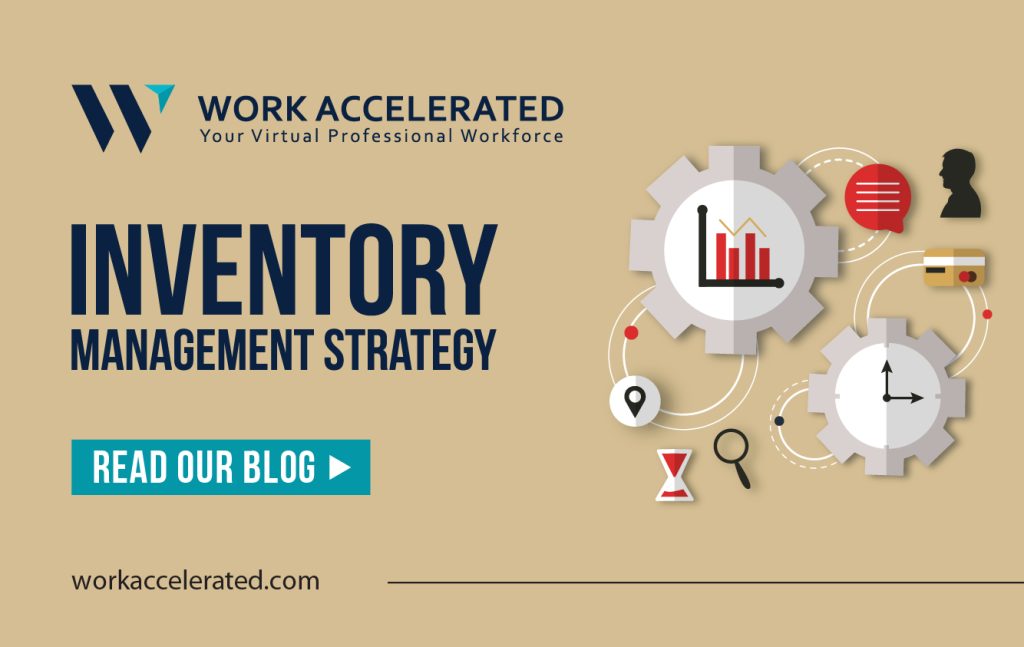Inventory management strategy is a set of processes and systems of ordering, storing, using, and selling a company’s inventory. This includes managing of raw materials, components, and finished products, as well as storing and processing of such items.
There are many different inventory management strategies, but some of the most common include:

Just-in-time (JIT) inventory management: This strategy involves ordering products only when needed, which can minimize inventory costs such as storage and processing costs. However, it can also lead to stockouts if demand is not accurately forecast.
Economic order quantity (EOQ): EOQ calculates the optimal order quantity for a product based on the product’s cost, demand, and carrying costs. It can help businesses minimize inventory costs while still meeting demand.
Materials requirements planning (MRP): This strategy uses previous demand data to forecast future demand and then calculates the inventory needed to meet that demand.
Push strategy: A push strategy means when retailers order inventory, and then try to sell the products they have in stock as soon as possible through aggressive advertising or marketing campaigns — in other words, they ‘push’ their existing stock toward consumers. This technique requires detailed customer demand forecasting, as businesses estimate how many units of a specific product they might require for the future. Push strategy involves ordering and shipping products only once within the required timeframe hence reducing manufacturing costs of the items.
Pull strategy: Business owners keep stock levels at a minimum to minimize costs and prevent storing more products than they might need in a pull strategy. A pull strategy determines the lowest possible inventory count one can keep in their warehouse rather than forecasting and hastily placing orders. Using this data, businesses can restock their shelves considering the items customers have already ordered and/or received. Following this trajectory can help companies reduce the risk of overstocking products they cannot sell, and cut warehousing costs since there would be less items to store. However, for a pull approach to work, business owners should analyze and replenish inventory fairly often if they want to avoid stockouts and delayed shipments that can harm their relationship with customers.
Conventional manufacturing strategy: In a conventional manufacturing strategy the assembly line is always on. This inventory management strategy can help keep machinery and team members from sitting idle for long periods. This strategy has its drawbacks, for instance if a department is inactive, it may be overwhelmed by an influx of incoming goods from the previous department. Thus, some businesses consider only producing a specific number of products each period, then holding on to their reserve for an unexpected surge or shortage.
Business owners can further refer to the following tips for creating an effective inventory management strategy:
Choosing the right warehouse location
You must choose the right locations for inventory warehousing. For instance, businesses who have a warehouse situated near their suppliers can be more responsive in meeting the clients’ demands.
Use data and analytics
Collect and analyze data on your inventory levels, demand, and costs to make informed decisions about your inventory strategy.
Automate your inventory management system
You can track inventory levels, forecast demand, and place orders more efficiently with an automated system
Consider Outsourcing/Offshore services
Considering an outsourcing firm to manage inventory can help business owners focus on key areas such as business development and B2C and B2B relations.
Use a safety stock
A safety stock is a buffer of inventory you keep in case of unexpected demand or delays in production or shipping.
Stay in touch with suppliers
Try to update your inventory needs so that you do not end up buying extra products that you may not need. Work with suppliers to ensure you have the right amount of inventory.
Demand and Supply Planning
Demand and supply planning requires a cross-functional approach, which involves the departments of sales, production, supply chain, and logistics. Business owners should keep a record of this process to ensure that everything is on track. Excel can be used to manage this process, or it may be overseen using specialized software. The business’ Enterprise Resource Planning (ERP) system can also be used to implement the Demand and Supply planning process.
Obsolete inventory
Business owners should plan for a stock obsolescence strategy since significant holding costs are associated with inventory management. Thus, having a process that can identify obsolete stock and a policy that deals with it in a timely manner can help business owners minimize costs on extra products.
Inventory Management and Tracking
Businesses owners can consider implementing an inventory tracking feature within their ERP systems that keeps a record of their products, their location and their codes or opt for an inventory management application that already offers all these features.
Vendor Agreements
Business owners should set agreements with their suppliers once they have settled their purchase schedules in accordance with their demand planning. This can save businesses from running out of raw material and packaging material inventory.
Strategize your Inventory Management with EA!
Business owners can also rely on outsourcing their inventory management functions and shift their focus to business development and strategic planning for their company’s growth. Amid the surging inflation, Expertise Accelerated can be your partner in handling accounting services from inventory management to payroll processing. Business owners have the freedom to choose resources from EA’s global talent pool who can help them in maintaining their inventory records.
EA CEO Haroon Jafree feels the plight of the US industry and is dedicated to providing business owners in the US the opportunity to have their very own inventory management specialist, all at a fraction of the cost. In turn, business owners can focus on key areas that can help their company gain a competitive foothold in the corporate world.

